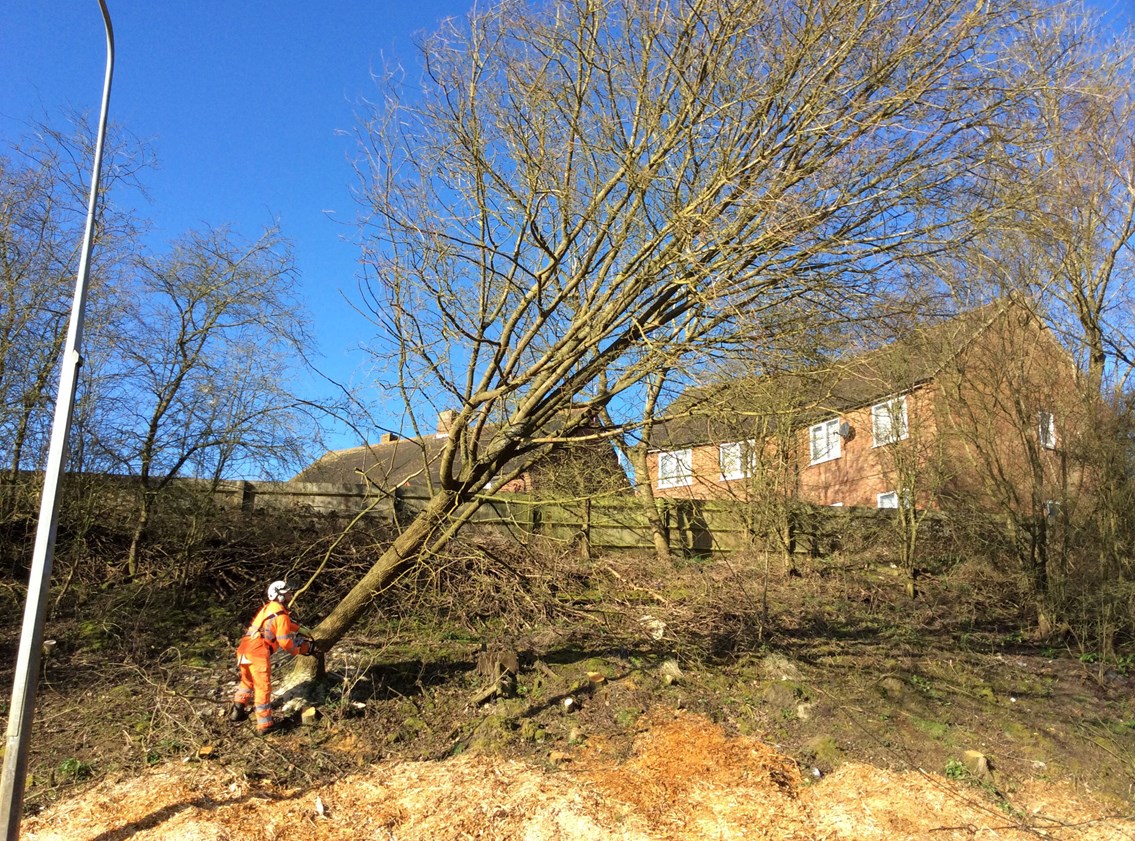Monday 10 Apr 2017
Residents between Rugby and Coventry invited to find out more about upcoming vegetation work
- Region & Route:
- | North West & Central
Residents living near to the railway in the villages of Brandon, Wolston, Church Lawford and Long Lawford are this week invited to attend local drop-in sessions to find out more about upcoming vegetation work in the area.
Last year across Britain around 1,000 trains collided with fallen trees or large branches – a number Network Rail is keen to reduce. Each year there are increased instances of trees and branches blocking or closing lines, disrupting passengers’ journeys.
Vegetation management work will take place along an 8 mile section of route between Willenhall Lane and Rugby from 24 April.
Residents are invited to attend either of two public information events to find out more about the activity, meet the project team and understand how the work might affect them.
Details of the events:
- Tuesday 11 April 2017 18:00 – 19:30 at Long Lawford Methodist Church, School Street, Long Lawford, Rugby , CV23 9AT
- Wednesday 12 April 2017 16:00 - 19:00 at Brandon and Wolston Village Hall, Main Street, Wolston, CV8 3HJ
Stephen Lowe, Senior Arborist at Network Rail said: “Vegetation management is an essential part of railway maintenance and is crucial to keeping both trains and passengers safe on the railway network.
“We encourage those living near the railway to come along and understand the work we are doing and how it may affect them. Our project team will be on hand to answer any questions and address any concerns they may have.”
Residents unable to attend the event can ask any questions or find out more information by calling our dedicated 24-hour National Helpline on: 03457 11 41 41.
ENDS
Notes to Editors
Vegetation removal – the facts
During a particularly stormy year in 2013, incidents caused by vegetation cost the railway industry £100m. Storm, rain and wind resulted in approximately 1,500 incidents in 2013-14 where fallen trees disrupted passengers.
With 20,000 miles of track and an estimated 2.5 million trees growing on the lineside, managing vegetation on the railway is not just a full-time job but one of our most important safety issues. Our climate, variety of trees and train frequency mean that the railway in Great Britain faces more serious challenges than most other countries.
Lineside vegetation can obscure signals, get blown onto the tracks, or grow to an extent where our staff do not have a safe place to wait whilst trains pass.
We will be removing lineside trees and plants which pose a significant safety or performance risk. Vegetation management also helps to prevent leaves falling on the track which can hamper train acceleration and braking.
Areas are assessed on a case-by-case basis, however all sites will see a clear six-metre wide corridor created (where available) on either side of the track, along with the removal of leaf fall species (for example ash and sycamore) and any trees tall enough to fall into the path of a train or onto other parts of the railway infrastructure.
Before works start Network Rail or our representatives carry out an ecological survey. Any protected species or nesting birds are identified and appropriate methods of working are put into place. Although the works do not require the submission of a planning application, where appropriate we will notify your local authority and any relevant statutory bodies.
To undertake these works, we will use a variety of equipment that can include chainsaws, flail machines, chipping machines or handsaws. Where suitable, logs and branches will either be left to create a safe habitat for wildlife; chipped and spread evenly; or will be completely removed from site.
Network Rail is very aware of the impact removing trees and vegetation can have on local communities. We particularly know that this can come as a something of a shock for people who have become accustomed to lines of trees or hedges near their homes or workplaces. However, for the safety of our passengers and employees we have no option but to take action to reduce the risk posed in order to operate a safe and reliable railway.
Contact information
Passengers / community members
Network Rail national helpline
03457 11 41 41
Latest travel advice
Please visit National Rail Enquiries
Journalists
Network Rail press office -Chelsea Green
Chelsea.Green@networkrail.co.uk
About Network Rail
We own, operate and develop Britain's railway infrastructure; that's 20,000 miles of track, 30,000 bridges, tunnels and viaducts and the thousands of signals, level crossings and stations. We run 20 of the UK's largest stations while all the others, over 2,500, are run by the country's train operating companies.
Usually, there are almost five million journeys made in the UK and over 600 freight trains run on the network. People depend on Britain's railway for their daily commute, to visit friends and loved ones and to get them home safe every day. Our role is to deliver a safe and reliable railway, so we carefully manage and deliver thousands of projects every year that form part of the multi-billion pound Railway Upgrade Plan, to grow and expand the nation's railway network to respond to the tremendous growth and demand the railway has experienced - a doubling of passenger journeys over the past 20 years.
Follow us on Twitter: @networkrail
Visit our online newsroom: www.networkrailmediacentre.co.uk

